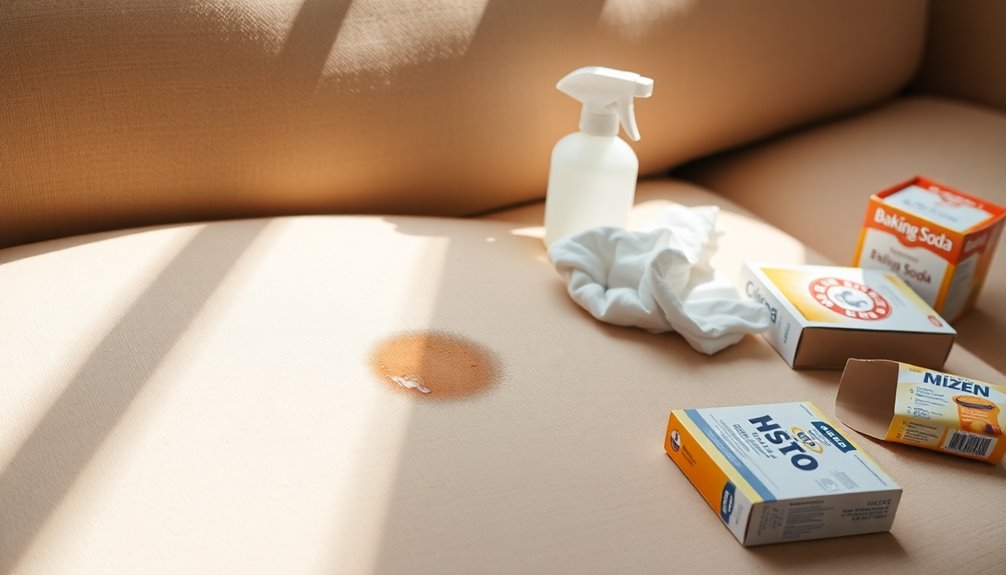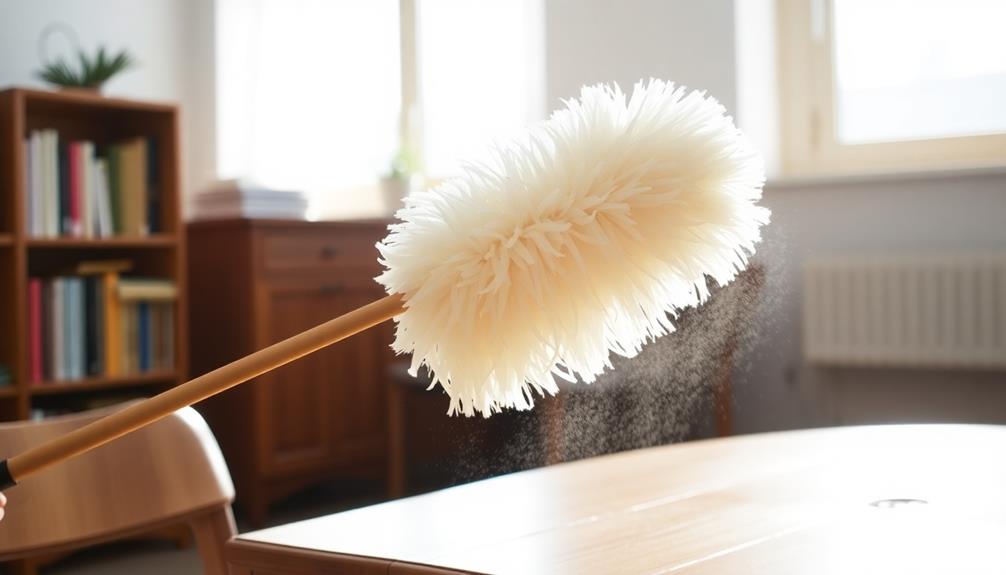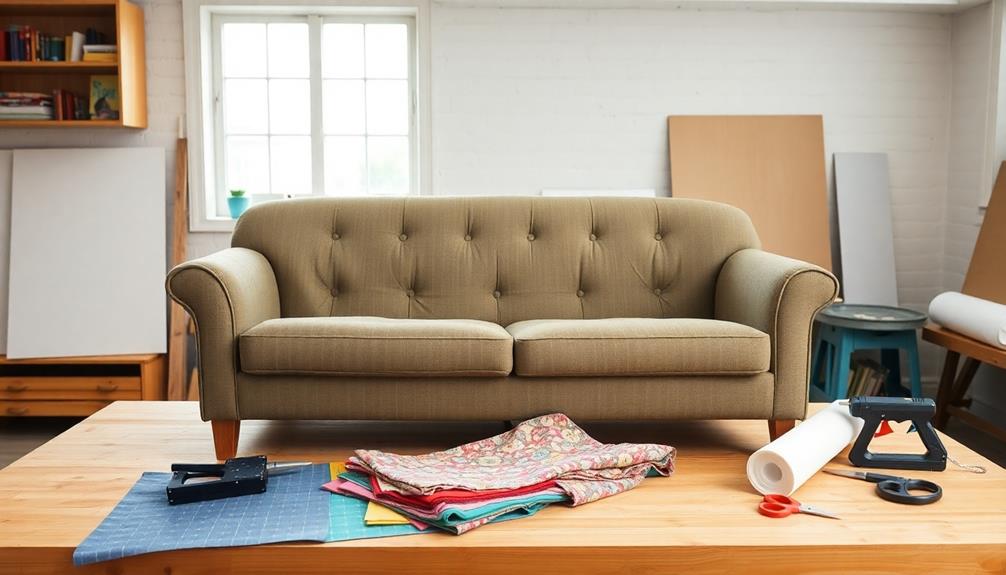To get rid of vomit smell on your sofa, act quickly. Start by wearing gloves and removing any solid vomit with paper towels. Blot the area gently to avoid spreading the stain. Mix equal parts white vinegar and warm water, and clean the affected area with a microfiber cloth. Afterwards, sprinkle baking soda over the spot and let it sit for several hours or overnight to absorb lingering odors. If the smell persists, consider using enzyme cleaners designed for organic stains. There are additional tips and techniques that can help maintain a fresh-smelling sofa, so keep exploring!
Key Takeaways
- Promptly remove vomit using gloves and paper towels, blotting instead of rubbing to prevent spreading the stain.
- Clean the area with equal parts white vinegar and warm water using a microfiber cloth.
- Sprinkle baking soda on the affected area and let it sit for several hours to absorb lingering odors.
- For persistent smells, consider using enzyme cleaners designed to target organic matter effectively.
- Allow ample drying time after cleaning to prevent mildew growth; repeat the process if the odor remains.
Introduction

When it comes to keeping your sofa fresh, routine upholstery care is key. You'll need to know fabric-specific cleaning techniques to tackle tough odors, especially vomit residue. Let's explore effective methods to eliminate those unpleasant smells and restore your sofa's comfort.
Routine Upholstery Care
Routine upholstery care is essential for keeping your sofa looking and smelling fresh. Regularly vacuuming your upholstery helps remove debris and allergens, which can contribute to odors, including the smell of vomit. Aim to vacuum at least once a week to maintain a clean environment. Additionally, using fabric protectors can repel stains and prevent spills from penetrating the fabric, making routine cleaning easier and more effective.
Educating your household members about proper upholstery care plays a crucial role, too. Encourage everyone to handle spills promptly and avoid eating on the sofa to reduce the chances of any mess that could lead to unpleasant odors. Scheduling professional cleaning every 6 to 12 months can help maintain your upholstery's appearance while preventing the buildup of stains and odors.
Lastly, keeping your upholstery in a well-ventilated area and using air purifiers can help reduce humidity levels, preventing mold and mildew growth that may lead to unpleasant smells. Incorporating regular filter changes for your air purifier can further enhance air quality and help eliminate odors. By implementing these routine cleaning practices, you'll not only effectively remove vomit odors but also prolong the life of your sofa, ensuring it remains a comfortable and inviting space in your home.
Fabric-Specific Cleaning Techniques
Even with consistent upholstery care, accidents can happen, and removing the smell of vomit from your sofa requires tailored cleaning techniques based on the fabric type. For a microfiber sofa, mix equal parts white vinegar and water. Use a cloth to apply the cleaning solution, being careful not to oversaturate the fabric. If your sofa is leather, dampen a cloth with mild soap, then follow up with a mixture of water and vinegar to neutralize odors without risking moisture damage.
Suede needs a gentle approach; use a suede brush to lift the fibers, then sprinkle baking soda on the affected area. Let it sit for a few hours to absorb odors before brushing it off. For natural fiber fabrics like cotton, combine dish soap and warm water for your cleaning solution, and allow the area to air dry completely to avoid mildew.
No matter the fabric type, always conduct a patch test on a small, inconspicuous area before applying any cleaning solution. This will help ensure compatibility and prevent any unwanted damage during the cleaning process.
Eliminating Vomit Residue Effectively
To effectively eliminate vomit residue from your sofa, quick action is crucial in preventing lasting stains and odors. Start by putting on gloves and grabbing some paper towels or an old rag. Carefully scoop up the vomit and dispose of it in a sealed plastic bag. This initial step is vital to avoid the vomit penetrating the fabric.
Next, it's time for cleaning. Mix equal parts white vinegar and warm water, and apply the solution with a microfiber cloth to the stained area. This will help break down the residue and remove the smell. After cleaning, sprinkle baking soda over the area. Allow it to sit for several hours or even overnight to absorb any lingering odors.
If the smell persists after your initial efforts, consider using an enzyme cleaner specifically designed to break down organic matter in vomit. These cleaners are effective at tackling stubborn odors and residue. Following these steps will help you restore your sofa to its fresh state, ensuring that any trace of vomit is effectively eliminated, leaving your space odor-free.
Sofa Shielding Techniques
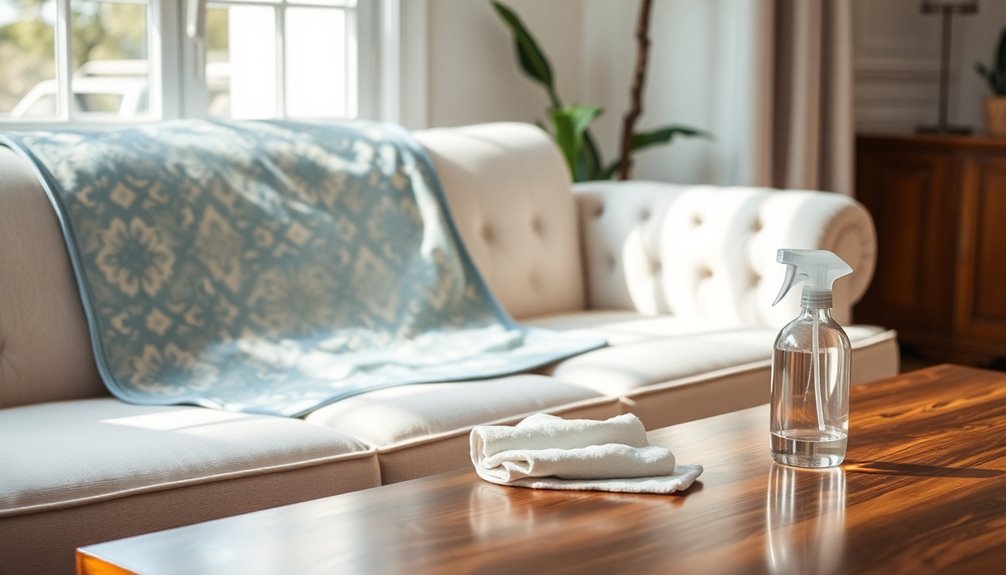
To keep your sofa safe from spills and odors, consider using scratch-resistant fabric options and protective fabric layers. These materials can provide an effective barrier against accidents, while a fabric protectant spray adds an extra layer of defense. By taking these steps, you'll minimize the risk of unpleasant smells lingering in your upholstery.
Scratch-Resistant Fabric Options
When you're looking for sofa options that can withstand the wear and tear of everyday life, scratch-resistant fabrics are a smart choice. These fabrics, like microfiber and synthetic blends, not only provide durability but also make cleaning easier compared to natural materials. Their tightly woven fibers help create a barrier against moisture and odors, preventing unpleasant smells from settling in.
High-performance upholstery options, such as treated polyester, offer enhanced resistance to scratching and staining, making them perfect for homes with pets or kids. Plus, many scratch-resistant fabrics are designed to be water-repellent, allowing for quicker cleanup of spills. This feature is crucial in stopping long-term odors from developing.
Choosing a sofa with removable, washable covers made from scratch-resistant fabric can significantly ease your cleaning process. You can simply take off the covers and toss them in the wash, helping you maintain a fresh-smelling environment. By selecting the right scratch-resistant fabric for your sofa, you'll not only enhance its longevity but also make your life a lot easier when it comes to keeping it clean and odor-free. Additionally, using essential oils for odor elimination can provide a pleasant fragrance to your living space.
Protective Fabric Layers
Even with scratch-resistant fabrics, taking extra precautions can help protect your sofa from spills and odors. One effective method is to invest in washable slipcovers or protective couch covers. These not only shield your sofa from potential stains but also make cleaning much easier. If an accident happens, you'll be grateful for the protective layers.
Consider keeping throw blankets on your sofa as well. They can absorb spills and are easy to wash, helping to prevent odors from settling into the upholstery. Regular maintenance is key: vacuuming and cleaning these protective layers frequently can keep your sofa smelling fresh and reduce any buildup of odors.
When buying a new sofa, choose stain-resistant materials like microfiber or leather. These fabrics are generally easier to clean and more resilient against spills, which means fewer worries for you. Additionally, while fabric protectors can be beneficial, you'll want to focus on those protective layers to minimize odor absorption during mishaps. Taking these steps ensures your sofa remains a comfortable haven, free from unpleasant surprises. Furthermore, using advanced cleaning technology can help maintain the freshness of your sofa by effectively removing odors and stains.
Using Fabric Protectant Spray
Applying a fabric protectant spray can significantly enhance your sofa's defenses against spills and odors. This spray creates a barrier on your upholstery that helps repel liquids and stains, making it easier to clean up vomit and preventing odors from penetrating the fabric. Before you apply the fabric protectant, ensure your sofa is clean and dry. Spray it evenly over the entire surface, and allow it to dry completely before using the sofa again.
Many fabric protectants contain water-repellent and stain-resistant properties that can last for up to six months. This ongoing protection is essential for maintaining your sofa's freshness. To maximize effectiveness, regularly reapply the fabric protectant every few months.
Always check the manufacturer's guidelines and test the protectant on a small, inconspicuous area of the sofa first to ensure compatibility with your fabric type. By taking these simple steps, you can significantly reduce the risk of future stains and odors, keeping your sofa looking and smelling great. With the right fabric protectant, you'll be better equipped to handle any mishaps that may come your way.
Upholstery Fabric Treatment Techniques

When tackling vomit odors on your sofa, you need to consider the integrity of the upholstery fabric first. You can explore various revitalization techniques to restore freshness while ensuring you don't damage the material. By using the right methods, you'll not only eliminate the smell but also enhance the overall appearance of your furniture.
Fabric Integrity Concerns
Maintaining the integrity of your sofa's upholstery is crucial, especially after an unfortunate incident like vomit. Before you dive into cleaning, always check the fabric care tag for cleaning codes (S, W, SW). This will guide you in selecting the right cleaning solution and prevent any damage to the upholstery.
Use gentle cleaning agents specifically designed for upholstery. Abrasive products can risk discoloration and compromise fabric integrity. If you're using water-based solutions, make sure not to over-saturate the fabric. Excess moisture can lead to water damage, mold, or mildew, which can significantly affect the structural integrity of your sofa.
For delicate fabrics like suede or microfiber, it's best to opt for low moisture cleaning methods. Conduct a patch test on an inconspicuous area first to ensure there are no adverse reactions or discoloration. If you're unsure about cleaning delicate fabrics, consider professional services to maintain their appearance and integrity. Taking these precautions will help you effectively tackle the vomit smell while keeping your sofa looking its best.
Upholstery Revitalization Techniques
Revitalizing your upholstery after a vomit incident doesn't have to be a daunting task. Start by mixing white vinegar with warm water to create a natural deodorizer. Apply this solution to the affected area to neutralize those unpleasant odors effectively. After that, sprinkle baking soda generously over the stained area. Let it sit for several hours or, ideally, overnight to absorb any lingering smells. Once it's done, vacuum it up for a fresher scent.
If the odor persists, consider using an enzyme cleaner designed to break down organic matter. This will help eliminate the source of the odor more effectively. For a deeper clean, employ a steam cleaner. This method penetrates deep into the fabric fibers, removing stains and odors while disinfecting the surface.
Finally, after you've cleaned the upholstery, consider applying a fabric protector. This creates a barrier against future stains and odors, ensuring that your upholstery stays fresh and lasts longer. By following these steps, you can effectively revitalize your upholstery and restore its freshness after a vomit incident.
Revitalizing Upholstery Freshness
Restoring freshness to your upholstery can be a straightforward process with the right techniques. First, you'll want to remove the vomit promptly. Use a mixture of equal parts white vinegar and water to neutralize odors. Apply this solution to the affected area and let it sit for 5-10 minutes before blotting with a clean cloth.
Next, sprinkle baking soda liberally over the stained area. Leave it for several hours or overnight to absorb lingering smells, then vacuum it up for a refreshed scent. For fabric couches, consider a hydrogen peroxide solution made of 2 cups hydrogen peroxide, 2 tablespoons of baking soda, and 2 drops of dish soap. Spray it directly on the affected area to target strong odors.
Regularly using a steam cleaner on your upholstery not only helps remove deep-seated odors but also disinfects the fabric. Just be sure to perform a patch test on an inconspicuous area before applying any cleaning solution. Implementing effective preventive maintenance strategies will significantly enhance the freshness of your upholstery, leaving it smelling clean and inviting once again.
Fabric Protectant Application Tips
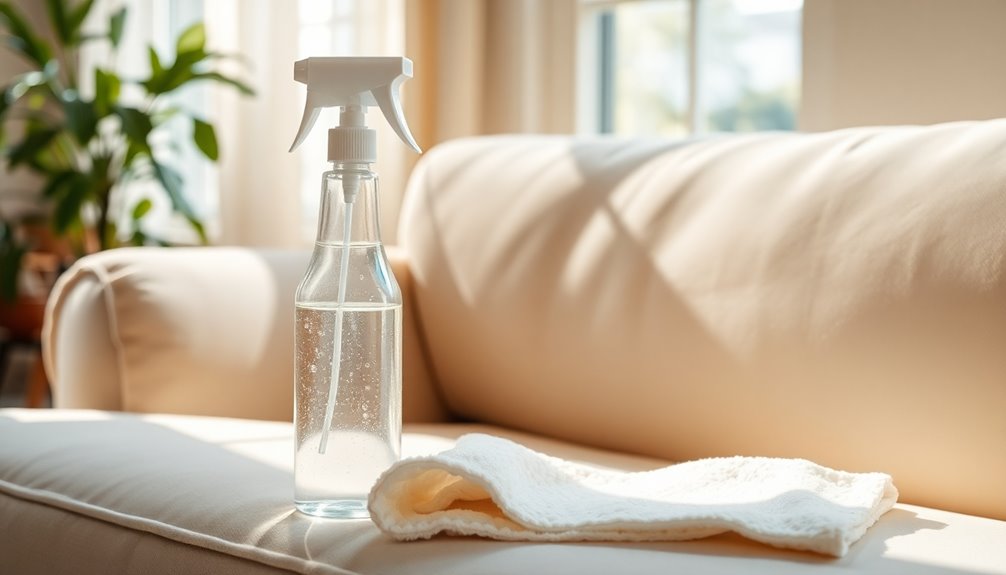
Choosing the right fabric protectant can make a significant difference in keeping your sofa looking fresh and free from odors. First, select a fabric protectant specifically designed for your sofa's upholstery to ensure compatibility. Before applying the protectant, it's crucial to clean the sofa thoroughly to remove any existing stains or odors. This step prepares the fabric for effective treatment.
Once your sofa is clean, test the fabric protectant on a small, inconspicuous area. This ensures it won't discolor or damage the fabric. If everything looks good, apply the protectant evenly using a spray bottle or cloth, making sure to cover all surfaces. Follow the manufacturer's instructions for drying times, and remember to let it air dry completely before using the sofa again.
To maintain the effectiveness of the fabric protectant, plan to reapply it every 6-12 months. Regular applications will help guard against stains and odors, keeping your sofa fresh longer. With these simple tips, you can enjoy a clean and pleasant-smelling sofa without the worry of unwanted odors returning. Additionally, using a high-quality fabric protectant can help enhance the longevity of your sofa's upholstery.
Preventive Maintenance for Upholstery
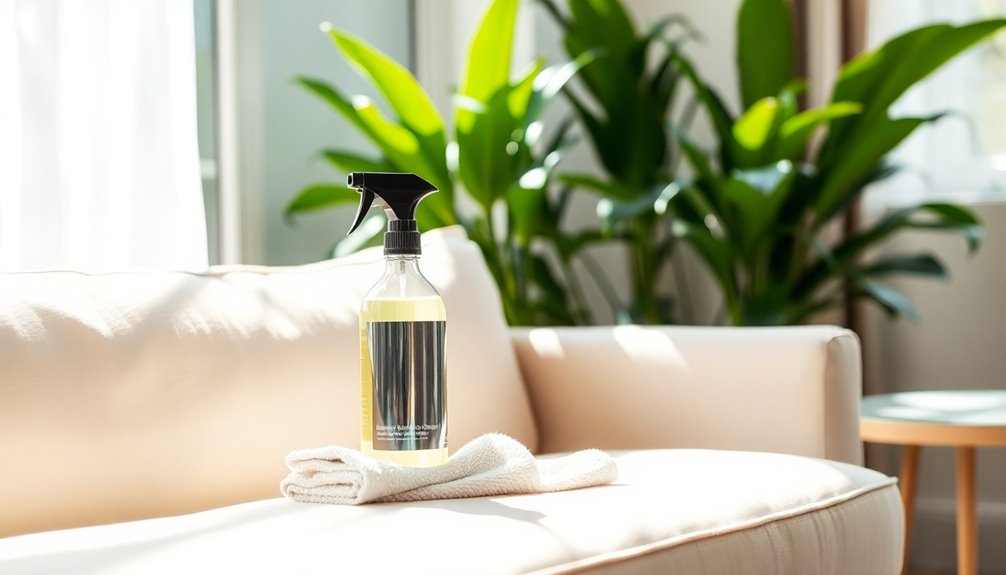
Preventive maintenance is essential for keeping your upholstery in top condition and free from unpleasant odors. One of the simplest yet most effective strategies is regularly vacuuming your sofa. This practice helps remove debris and potential odor-causing particles, preventing them from building up over time. Additionally, consider applying fabric protectors to create a barrier against stains and odors, making it easier to clean spills before they penetrate the fabric.
When accidents happen, address spills immediately by blotting with a clean cloth and using appropriate cleaning solutions to prevent lasting damage. Regular maintenance doesn't stop there; scheduling professional upholstery cleaning at least once a year is crucial for maintaining the fabric's integrity and reducing the likelihood of odors developing. A clean home environment also contributes to minimizing odors and promoting overall health.
Finally, keep your living space well-ventilated and maintain low humidity levels. This helps prevent mold growth and associated odors in your upholstery. By following these preventive maintenance tips for upholstery, you'll not only keep your furniture looking great but also ensure it remains fresh and inviting for years to come.
Conclusion

In conclusion, tackling vomit smell on your sofa requires prompt action and the right cleaning techniques. First, address the affected area immediately using a mixture of white vinegar and warm water. This natural deodorizer is effective in breaking down the odor. After you've cleaned the area, sprinkle baking soda on top to absorb any lingering smells. Let it sit for several hours before you vacuum it up to ensure maximum effectiveness.
If you still notice a persistent odor, consider using an enzyme cleaner specifically designed to target organic matter. This can help eliminate the smell at its source. Throughout the cleaning process, make sure to ventilate the area by opening windows and using fans. This helps disperse any remaining odors, making your efforts more effective.
If your DIY methods fail to remove the vomit smell, don't hesitate to seek professional upholstery cleaning services. They have the tools and expertise to address stubborn odors effectively. Remember, the sooner you act, the better your chances of restoring your sofa to its original freshness.
Frequently Asked Questions
How Do You Get Vomit Smell Out of Couch?
To get rid of that unpleasant smell, start by removing any solid remnants and blotting the area gently. Mix equal parts white vinegar and water, applying it to the spot and letting it sit for a few minutes. Sprinkle baking soda over the area to absorb lingering odors, letting it sit for several hours. Finally, vacuum up the baking soda and consider using an enzyme cleaner for any stubborn smells. Ensure everything dries well!
What Neutralizes the Smell of Vomit?
To neutralize the smell of vomit, you can use several effective methods. Start with white vinegar mixed with water; spray it on the area and let it sit before blotting. Baking soda is another great option—just sprinkle it on and let it absorb odors for hours. You can also try hydrogen peroxide, coffee grounds, or activated charcoal to tackle strong smells. Each option helps break down the odor and leaves your space smelling fresh again.
How Do You Get the Smell Out of a Fabric Couch?
To get the smell out of a fabric couch, start by blotting any stains with paper towels to absorb moisture. Mix equal parts water and white vinegar, apply it to the affected area, and let it sit for 5-10 minutes before blotting it dry. Sprinkle baking soda over the area and let it sit for hours to absorb odors. Finally, vacuum the area to remove the baking soda and keep your couch fresh.
Does Vomit Smell Go Away Over Time?
Vomit smell doesn't usually go away on its own. If you leave it untreated, it can linger indefinitely, especially in upholstery. The odor seeps deep into fabric fibers and can become more entrenched over time, mixing with other household smells. Factors like humidity and the type of fabric can affect how long the smell lasts. To avoid a persistent odor, you need to clean and deodorize the affected area promptly.
